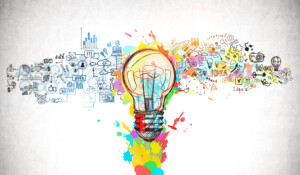 Ling Ling Sun is Chief Technology Officer at Nebraska Public Media and the Chair of the 2024 NAB Broadcast Engineering and IT Conference Program Committee
Ling Ling Sun is Chief Technology Officer at Nebraska Public Media and the Chair of the 2024 NAB Broadcast Engineering and IT Conference Program Committee The 2024 NAB Show will be a stage for a remarkable performance – a symphony of human creativity, machine power and artificial intelligence (AI). This isn’t a battle for dominance; it’s a powerful new act in the ever-evolving story of media creation. AI isn’t here to replace the irreplaceable human touch – it’s here to become a vital partner in the creative trilogy.
A Legacy Built on Teamwork
 Media creation has always been a collaborative effort. From the invention of the camera, a physical device capturing light, to the editing software running on computers, each technological leap has been a testament to the human-machine partnership. But the heart of storytelling has always resided with the human – the guiding eye behind the lens, the hand shaping the narrative, the emotions poured into every scene.
Media creation has always been a collaborative effort. From the invention of the camera, a physical device capturing light, to the editing software running on computers, each technological leap has been a testament to the human-machine partnership. But the heart of storytelling has always resided with the human – the guiding eye behind the lens, the hand shaping the narrative, the emotions poured into every scene.
Heading to NAB Show? Use our Daily Guides for Broadcast Engineers and Media Technologists to help schedule your time.
AI: The Amplifying Force
In this evolving landscape, AI emerges as a transformative force. It acts as a powerful amplifier, not just for machines, but for human capabilities as well.
The AI Conductor: By analyzing real-world recordings, AI can automatically remove background noise for crystal-clear audio or adjust levels for optimal listening across devices. It can even isolate specific instruments or voices, giving human sound editors complete control in post-production.
The Smart Editing Assistant: Editing suites are poised for a transformation. AI co-pilots will analyze footage captured by physical cameras, suggesting edits based on pacing, emotional impact and storytelling principles. This frees human editors to focus on the more nuanced creative decisions – crafting a cohesive narrative flow and injecting artistic flourishes.
The VFX Muse: Special effects creation, often a time-consuming process, can benefit from AI’s analytical prowess. AI algorithms can generate realistic green screen backdrops that seamlessly integrate with physical sets. It can suggest potential effects based on the content and desired mood or recommend techniques for creating flawless transitions and natural-looking compositing, empowering human artists to bring their visions to life.
The Personalized Bard: AI can personalize content delivery based on individual preferences gleaned from user data. It can optimize content delivery for smooth playback on any device, ensuring a seamless experience. Real-time captioning and translation powered by AI can break down language barriers and expand audience reach, catering to a global audience with the help of physical broadcasting machines.
The Human-Machine-AI Symphony: A Shared Stage
The success of this AI-powered future hinges on a shared stage. Let’s highlight the importance of seamless integration between AI, existing infrastructures and established human workflows. Human creators will remain at the helm, leveraging AI’s strengths and the power of physical machines to automate tasks, analyze vast amounts of data and identify patterns. This frees them to focus on the irreplaceable human touch – crafting compelling narratives, making strategic content decisions and injecting the emotional core that resonates with audiences.
Beyond the Show: A Future Filled with Potential
The impact of AI extends beyond the studios. It has the potential to democratize media creation by empowering individuals and smaller production houses. With AI-powered editing software and cloud-based rendering farms (which themselves rely on physical infrastructure), professional-quality content creation becomes more accessible. Additionally, AI-driven content analysis can provide valuable insights for audience engagement and content optimization, leading to a more data-driven approach to storytelling within the human-machine-AI trilogy.
The Journey into this AI-powered Future Requires a Collaborative Composition
Education and Training: Upskilling the workforce is crucial. Media professionals need to understand AI capabilities and limitations to leverage them effectively within existing workflows alongside the machines they utilize.
Open Dialogue and Collaboration: Fostering open communication between developers, policymakers and media professionals is essential. Discussions on ethical considerations, responsible development practices and the establishment of industry-wide standards for AI integration in media creation are key to a successful human-machine-AI symphony.
Investing in Innovation: Continued investment in AI research and development that considers the human-machine partnership is vital for responsible and effective integration within the media landscape. At NAB Show 2024, advancements in AI tools specifically designed for media creation applications could encourage further innovation and exploration.
Bridging the Gap between Generative AI and Real-World Storytelling
While generative AI often focuses on its potential to create content from prompts, NAB Show takes a different approach. The focus here is on “real-world” applications – the tangible tools that media organizations use every day: cameras, editing software, rendering engines, asset management, playout and distribution channels. These elements remain crucial for crafting compelling narratives. NAB Show differentiates itself by demonstrating how generative capabilities, including AI, can meet the needs of the storytelling community, operating within the confines of real-world production environments.

